- 1
- 2
- 3
ELIQUIS is indicated to reduce the risk of stroke and systemic embolism in adult patients with nonvalvular atrial fibrillation (NVAF).
Eliquis indicated for the treatment of adults with deep vein thrombosis (DVT) and pulmonary embolism (PE), and to reduce the risk of recurrent DVT and PE following initial therapy.
Eliquis is indicated for the prophylaxis of deep vein thrombosis (DVT), which may lead to pulmonary embolism (PE), in adult patients who have undergone hip or knee replacement surgery.
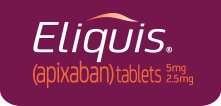

U.S. FULL PRESCRIBING INFORMATION, including Boxed WARNINGS
Please verify that you are a U.S. Healthcare Professional
U.S. FULL PRESCRIBING INFORMATION, including Boxed WARNINGS
Please verify that you are a U.S. Healthcare Professional
Leaving hcp.eliquis.com
XYou are about to leave the Bristol Myers Squibb and Pfizer hcp.eliquis.com site. You are being redirected to a Bristol Myers Squibb corporate site.
Would you like to leave this site?
Leaving hcp.eliquis.com X
You are about to leave the Bristol Myers Squibb and Pfizer hcp.eliquis.com site. Bristol Myers Squibb and Pfizer are not responsible for the content of such other sites. Links to other sites are provided only as a convenience to users of this site.
Would you like to leave this site?
Leaving hcp.eliquis.com X
You are about to leave the Bristol Myers Squibb and Pfizer hcp.eliquis.com site. You are being redirected to a Pfizer corporate site.
Would you like to leave this site?
Leaving hcp.eliquis.com X
You are about to leave the Bristol Myers Squibb and Pfizer hcp.eliquis.com site. You are being redirected to an external site for information on ELIQUIS® (apixaban) samples.
Would you like to leave this site?
Contact us
XFor your convenience, specialized Bristol Myers Squibb representatives are available by phone or email to help you with your medical, technical, or general inquiries.
General and technical inquiries
(877) 517-6326 (Monday–Friday, 8 AM–8 PM ET)
Adverse event or product quality complaints
Medical information inquiries
BMSMedInfo.com to search online or email your inquiry (login or registration required)
(800) 321-1335 (Monday–Friday, 8 AM–5 PM ET)
432-US-2300211 06/23
Select document to view or download
XIf you need Adobe® Reader®, click the link below to download the free reader.
Link to Adobe Reader download pageSelect document to view or download
XIf you need Adobe® Reader®, click the link below to download the free reader.
Link to Adobe Reader download pageChoose ELIQUIS for the treatment of DVT and PE, and to reduce the risk of recurrent DVT and PE following initial therapy
ONLY ELIQUIS demonstrated BOTH comparable efficacy AND superiority in major bleeding events vs enoxaparin/warfarin1
COMPARABLE

PRIMARY EFFICACY ENDPOINT
SUPERIOR

PRIMARY SAFETY ENDPOINT
ELIQUIS increases the risk of bleeding and can cause serious, potentially fatal, bleeding.1
- Discontinuation rate due to bleeding events: 0.7% with ELIQUIS vs 1.7% with enoxaparin/warfarin
- In AMPLIFY, the most commonly observed adverse reactions in ELIQUIS-treated patients (incidence ≥1%) were epistaxis, contusion, hematuria, menorrhagia, hematoma, hemoptysis, rectal hemorrhage, and gingival bleeding
Consistent efficacy and rates of major bleeding across key patient subgroups2
Renal Impairment
Age
Weight
Gender
ARR=absolute risk reduction; CI=confidence interval; DVT=deep vein thrombosis; PE=pulmonary embolism; RR=relative risk; RRR=relative risk reduction; VTE=venous thromboembolism.
*Recurrent symptomatic VTE (nonfatal DVT or nonfatal PE).
†Bleeding events associated with each endpoint were counted once per subject, but subjects may have contributed events to multiple endpoints.
‡RRR was calculated as (1-RR) X 100. ARR is calculated as the difference between the incidences and is expressed as percentage points.
AMPLIFY Study Design
A randomized, double-blind, phase III trial to determine whether ELIQUIS was noninferior to enoxaparin/warfarin for the incidence of recurrent VTE* or VTE-related death in 5400 patients with objectively confirmed, symptomatic proximal DVT and/or PE. 2693 patients were randomized to ELIQUIS 10 mg orally twice daily for 7 days followed by 5 mg orally twice daily for 6 months, and 2707 patients were randomized to standard of care at the time, which was enoxaparin 1 mg/kg twice daily subcutaneously for at least 5 days (until INR ≥2) followed by warfarin (target INR range: 2.0–3.0) orally for 6 months. The primary efficacy endpoint was recurrent VTE* or VTE-related death, and the primary safety endpoint was major bleeding.1,2
≈90% of patients in the AMPLIFY trial had an unprovoked DVT/PE at baseline.1
- The 10% of patients with a provoked DVT/PE were required to have an additional ongoing risk factor in order to be randomized§
*Recurrent symptomatic VTE (nonfatal DVT or nonfatal PE).
§Risk factors included previous episode of DVT/PE, immobilization, history of cancer, active cancer, and known prothrombotic genotype.
Major bleeding was defined as clinically overt bleeding accompanied by one or more of the following2,4:
- A decrease in hemoglobin of ≥2 g/dL
- A transfusion of 2 or more units of packed red blood cells
- Bleeding that occurred in at least 1 of the following critical sites: intracranial, intraspinal, intraocular, pericardial, intra-articular, intramuscular with compartment syndrome, or retroperitoneal
- Fatal bleeding
ELIQUIS was studied across various patient subgroups
| ELIQUIS (n=2691) |
enoxaparin/ warfarin (n=2704) |
|
|---|---|---|
| Extensive PE at baseline|| | 13.3% (n=357) | 12.1% (n=326) |
| Weight ≥100 kg | 19.4% (n=522) | 19.2% (n=518) |
| Moderate renal impairment (CrCl >30 to ≤50 mL/min) | 6.0% (n=161) | 5.5% (n=148) |
| Severe renal impairment (CrCl ≤30 mL/min) | 0.5% (n=14) | 0.6% (n=15) |
| Previous VTE | 17.2% (n=463) | 15.1% (n=409) |
| Active cancer3¶ | 3.3% (n=88) | 3.0% (n=81) |
- Patients with creatinine clearance <25 mL/min were excluded
- Patients were excluded if they had cancer and 6 months or more of treatment with low-molecular-weight heparin was planned
Active cancer baseline values were taken from the journal publication Agnelli G, Buller HR, Cohen A, et al. Oral apixaban for the treatment of venous thromboembolism in cancer patients: results from the AMPLIFY trial. J Thromb Haemost. 2015;13:2187-2191.
||Pulmonary embolism was defined as extensive if there were 2 or more lobes involving 50% or more of the vasculature for each lobe.
¶Active cancer was defined as cancer diagnosed or treated within the past 6 months without the necessity for low-molecular-weight heparin treatment.
CrCl=creatinine clearance; DVT=deep vein thrombosis; PE=pulmonary embolism; VTE=venous thromboembolism.
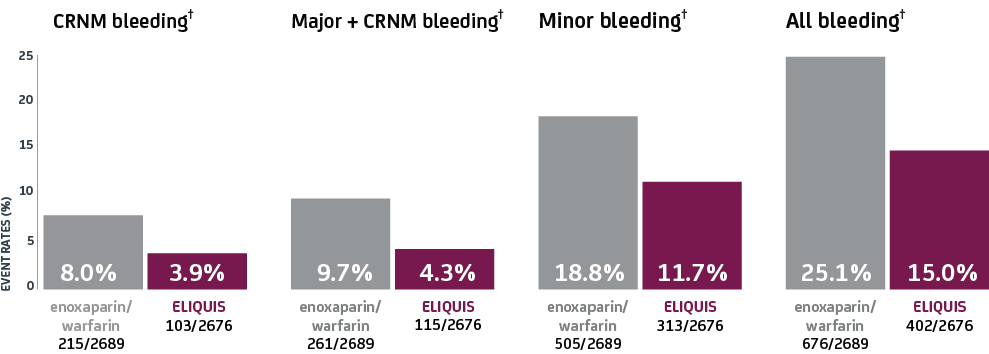
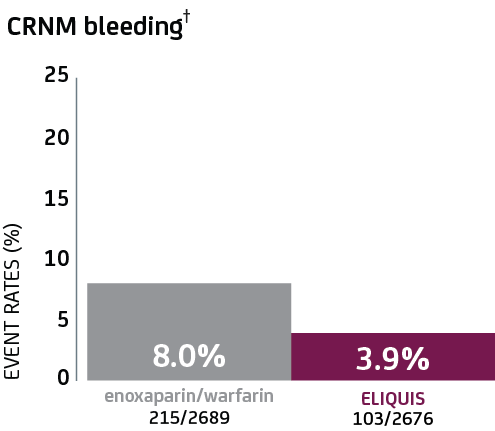
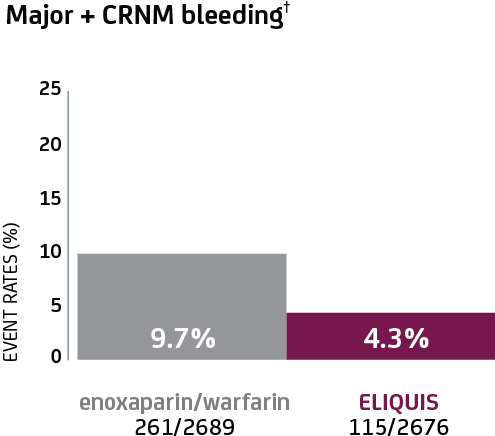
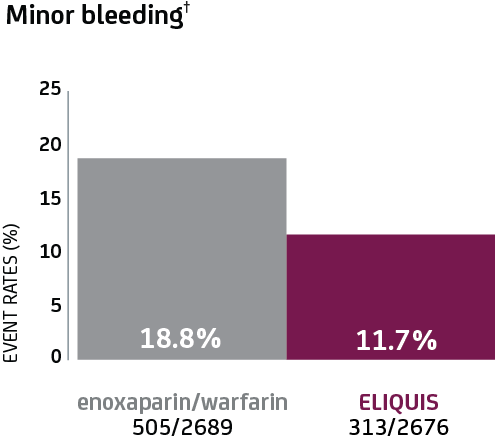
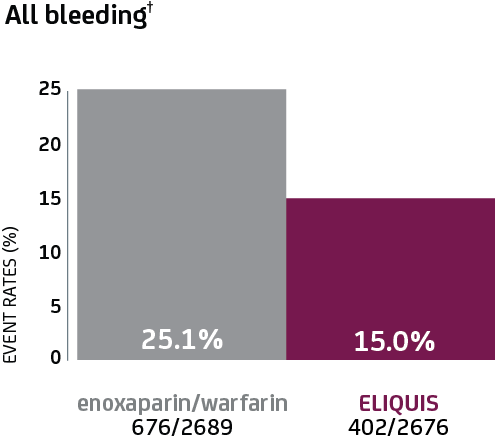
ELIQUIS increases the risk of bleeding and can cause serious, potentially fatal, bleeding.1
- In AMPLIFY, the discontinuation rate due to bleeding events was 0.7% in the ELIQUIS-treated patients compared to 1.7% in the enoxaparin/warfarin-treated patients1
CRNM bleeding was defined as overt bleeding not meeting the criteria for major bleeding but associated with at least 1 of the following: medical intervention, contact with a physician, interruption of the study drug, or discomfort or impairment in carrying out activities of daily life.2
†Bleeding events associated with each endpoint were counted once per subject, but subjects may have contributed events to multiple endpoints.
Select examples of CRNM bleeding2
-
Any bleeding leading to hospitalization
-
Macroscopic gastrointestinal hemorrhage, including at least one episode of melena or hematemesis, if clinically apparent with positive results on a fecal occult-blood test
-
Epistaxis lasting >5 minutes, that was repetitive, or that led to an intervention
-
Macroscopic, spontaneous hematuria or hematuria lasting >24 hours after instrumentation of the urogenital tract
-
Hemoptysis (if more than a few speckles in the sputum and not occurring within the context of PE)
-
- Any bleeding compromising hemodynamics
- Any other bleeding type considered to have clinical consequences to a patient
Bleeding definitions
Major bleeding was defined as clinically overt bleeding accompanied by one or more of the following2,4:
- A decrease in hemoglobin of ≥2 g/dL
- A transfusion of 2 or more units of packed red blood cells
- Bleeding that occurred in at least 1 of the following critical sites: intracranial, intraspinal, intraocular, pericardial, intra-articular, intramuscular with compartment syndrome, or retroperitoneal
- Fatal bleeding
Clinically relevant nonmajor (CRNM) bleeding was defined as clinically overt bleeding that did not satisfy the criteria for major bleeding but was associated with at least 1 of the following2:
- Medical intervention
- Contact with a physician
- Interruption of the study drug
- Discomfort or impairment in carrying out activities of daily life
Minor bleeding was defined as all acute clinically overt bleeding events not meeting the criteria for either major bleeding or clinically relevant nonmajor bleeding.2
AMPLIFY: a randomized, double-blind, phase III noninferiority trial1,2
Study objective: To determine whether ELIQUIS was noninferior to enoxaparin/warfarin for the incidence of recurrent VTE* or VTE-related death.


- Primary efficacy endpoint: Recurrent VTE* or VTE-related death
- Primary safety endpoint: Major bleeding
DVT=deep vein thrombosis; INR=international normalized ratio; PE=pulmonary embolism; VTE=venous thromboembolism.
*Recurrent symptomatic VTE (nonfatal DVT or nonfatal PE).
Select inclusion criteria: Objectively confirmed, symptomatic proximal DVT and/or PE.
Select exclusion criteria: Patients who required thrombectomy, insertion of a caval filter, or use of a fibrinolytic agent, and patients with a life expectancy of <6 months, a creatinine clearance <25 mL/min, significant liver disease, an existing heart valve or atrial fibrillation, or active bleeding, or cancer and for whom long-term treatment with low-molecular-weight heparin was planned.
Baseline characteristics: Approximately 90% of patients had an unprovoked DVT or PE at baseline, and 10% of patients with a provoked DVT or PE were required to have an additional ongoing risk factor, which included previous episode of DVT or PE, immobilization, history of cancer, active cancer, and known prothrombotic genotype. Patients were allowed to enter the study with or without prior parenteral anticoagulation (up to 48 hours).
Major bleeding was defined as clinically overt bleeding accompanied by one or more of the following2,4:
- A decrease in hemoglobin of ≥2 g/dL
- A transfusion of 2 or more units of packed red blood cells
- Bleeding that occurred in at least one of the following critical sites: intracranial, intraspinal, intraocular, pericardial, intra-articular, intramuscular with compartment syndrome, or retroperitoneal
- Fatal bleeding
SUPERIOR

PRIMARY EFFICACY ENDPOINT
SIMILAR TO PLACEBO

PRIMARY SAFETY ENDPOINT
ELIQUIS increases the risk of bleeding and can cause serious, potentially fatal, bleeding.1
- Discontinuation rate due to bleeding events: 1.0% in ELIQUIS-treated patients vs 0.4% with placebo
- In AMPLIFY-EXT, the most commonly observed adverse reactions in ELIQUIS-treated patients (incidence ≥1%) were epistaxis, hematuria, hematoma, contusion, and gingival bleeding
ARR=absolute risk reduction; CI=confidence interval; DVT=deep vein thrombosis; NS=nonsignificant; PE=pulmonary embolism; RR=relative risk; RRR=relative risk reduction; VTE=venous thromboembolism.
*Recurrent symptomatic VTE (nonfatal DVT or nonfatal PE).
†Bleeding events associated with each endpoint were counted once per subject, but subjects may have contributed events to multiple endpoints.
‡RRR was calculated as (1-HR) X 100. ARR was calculated as the difference between the event rates.
AMPLIFY-EXT Study Design
A randomized, double-blind, phase III trial to compare the efficacy and safety of ELIQUIS vs placebo in patients who had been treated for DVT and/or PE for 6 to 12 months with anticoagulation therapy without having a recurrent event, and for whom physicians were uncertain about continuing anticoagulation therapy. 1671 patients§ with objectively confirmed, symptomatic proximal DVT and/or PE were randomized to ELIQUIS 2.5 mg orally twice daily for 12 months (n=842) or placebo for 12 months (n=829). The primary efficacy endpoint was recurrent VTE* or all-cause death, and the primary safety endpoint was major bleeding.1,4
≈92% of patients in the AMPLIFY-EXT trial had an unprovoked DVT/PE at baseline.1
- The remaining 8% of patients had a provoked baseline event and one additional risk factor for recurrence
*Recurrent symptomatic VTE (nonfatal DVT or nonfatal PE).
§In AMPLIFY-EXT, 2486 patients were randomized, with 815 of these patients randomized to ELIQUIS 5 mg twice daily, which is not an approved dose for this indication.
Major bleeding was defined as clinically overt bleeding accompanied by one or more of the following2,4:
- A decrease in hemoglobin of ≥2 g/dL
- A transfusion of 2 or more units of packed red blood cells
- Bleeding that occurred in at least one of the following critical sites: intracranial, intraspinal, intraocular, pericardial, intra-articular, intramuscular with compartment syndrome, or retroperitoneal
- Fatal bleeding
| Placebo n=826 |
ELIQUIS 2.5 mg twice daily n=840 |
|
|---|---|---|
| CRNM bleeding | 2.3% (n=19) | 3.0% (n=25) |
| Major + CRNM bleeding | 2.7% (n=22) | 3.2% (n=27) |
| Minor bleeding | 7.0% (n=58) | 8.9% (n=75) |
| All bleeding | 9.0% (n=74) | 11.2% (n=94) |
CRNM=clinically relevant nonmajor.
†Bleeding events associated with each endpoint were counted once per subject, but subjects may have contributed events to multiple endpoints.
ELIQUIS increases the risk of bleeding and can cause serious, potentially fatal, bleeding.1
- In AMPLIFY-EXT, the discontinuation rate due to bleeding events was approximately 1% in the ELIQUIS-treated patients compared to 0.4% in those patients in the placebo group
Bleeding definitions
Major bleeding was defined as clinically overt bleeding accompanied by 1 or more of the following4:
- Hemoglobin decrease—A decrease in hemoglobin of 2 g/dL or more;
- Transfusion—A transfusion of 2 or more units of packed red blood cells;
- Critical site bleeding—Bleeding that occurred in at least 1 of the following critical sites: intracranial, intraspinal, intraocular, pericardial, intra-articular, intramuscular with compartment syndrome, or retroperitoneal;
- Fatal bleeding
Clinically relevant nonmajor (CRNM) bleeding was defined as clinically overt bleeding that did not satisfy the criteria for major bleeding and that led to4:
- Medical intervention
- Contact with a physician
- Interruption of the study drug
- Discomfort or impairment in carrying out activities of daily life
Minor bleeding was defined as all acute clinically overt bleeding events not meeting the criteria for either major bleeding or clinically relevant nonmajor bleeding.
AMPLIFY-EXT: a randomized, double-blind, phase III trial1,4
Study objective: To compare the efficacy and safety of ELIQUIS vs placebo in patients who had been treated for DVT and/or PE for 6 to 12 months with anticoagulation therapy without having a recurrent event, and for whom physicians were uncertain about continuing anticoagulation therapy.


- Primary efficacy endpoint: Recurrent VTE† or all-cause death
- Primary safety endpoint: Major bleeding
Why placebo?
The placebo arm simulates DVT/PE patients who would have received no further treatment after completing initial therapy.4
DVT=deep vein thrombosis; PE=pulmonary embolism; VTE=venous thromboembolism.
*In AMPLIFY-EXT, 2486 patients were randomized, with 815 of these patients randomized to ELIQUIS 5 mg twice daily, which is not an approved dose for this indication.
†Recurrent symptomatic VTE (nonfatal DVT or nonfatal PE).
Select inclusion criteria: Objectively confirmed, symptomatic proximal DVT and/or PE.
Select exclusion criteria: Multiple episodes of unprovoked DVT or PE.
Baseline characteristics:
- Patients had either an unprovoked DVT or PE at baseline (approximately 92%) or a provoked baseline event and one additional risk factor for recurrence (approximately 8%). Risk factors for recurrent VTE are: Active cancer, persistent or permanent immobilization, previous DVT or PE, known prothrombotic genotype, or use of antiplatelet agents4
- Approximately one-third of patients participated in the AMPLIFY study prior to enrollment in AMPLIFY-EXT1
Major bleeding was defined as clinically overt bleeding accompanied by at least one of the following2,4:
- Hemoglobin decrease—A decrease in hemoglobin of ≥2 g/dL;
- Transfusion—A transfusion of 2 or more units of packed red blood cells;
- Critical site bleeding—Bleeding that occurred in at least 1 of the following critical sites: intracranial, intraspinal, intraocular, pericardial, intra-articular, intramuscular with compartment syndrome, or retroperitoneal;
- Fatal bleeding
View recommended dosing for:
Treatment of DVT/PEReduction in risk of recurrent DVT/PE following initial therapy
References
- ELIQUIS® (apixaban) Package Insert. Bristol-Myers Squibb Company, Princeton, NJ, and Pfizer Inc, New York, NY.
- Agnelli G, Buller HR, Cohen A, et al. Oral apixaban for the treatment of acute venous thromboembolism. N Engl J Med. 2013;369(9):799-808. Supplement available at http://www.nejm.org/doi/suppl/10.1056/
NEJMoa1302507/suppl_file/
nejmoa1302507_appendix.pdf. Accessed August 2019. - Agnelli G, Buller HR, Cohen A, et al. Oral apixaban for the treatment of venous thromboembolism in cancer patients: results from the AMPLIFY trial. J Thromb Haemost. 2015;13:2187-2191.
- Agnelli G, Buller HR, Cohen A, et al. Apixaban for the extended treatment of venous thromboembolism. N Engl J Med. 2013;368(8):699-708. Supplement available at http://www.nejm.org/doi/suppl/10.1056/NEJMoa1207541/suppl_file/
nejmoa1207541_appendix.pdf. Accessed August 2019.
WARNING: (A) PREMATURE DISCONTINUATION OF ELIQUIS INCREASES THE RISK OF THROMBOTIC EVENTS, (B) SPINAL/EPIDURAL HEMATOMA
(A) Premature discontinuation of any oral anticoagulant, including ELIQUIS® (apixaban), increases the risk of thrombotic events. If anticoagulation with ELIQUIS is discontinued for a reason other than pathological bleeding or completion of a course of therapy, consider coverage with another anticoagulant.
(B) Epidural or spinal hematomas may occur in patients treated with ELIQUIS who are receiving neuraxial anesthesia or undergoing spinal puncture. These hematomas may result in long-term or permanent paralysis. Consider these risks when scheduling patients for spinal procedures. Factors that can increase the risk of developing epidural or spinal hematomas in these patients include:
- use of indwelling epidural catheters
- concomitant use of other drugs that affect hemostasis, such as nonsteroidal anti-inflammatory drugs (NSAIDs), platelet inhibitors, other anticoagulants
- a history of traumatic or repeated epidural or spinal punctures
- a history of spinal deformity or spinal surgery
- optimal timing between the administration of ELIQUIS and neuraxial procedures is not known
Monitor patients frequently for signs and symptoms of neurological impairment. If neurological compromise is noted, urgent treatment is necessary.
Consider the benefits and risks before neuraxial intervention in patients anticoagulated or to be anticoagulated.
- Active pathological bleeding
- Severe hypersensitivity reaction to ELIQUIS (e.g., anaphylactic reactions)
- Increased Risk of Thrombotic Events after Premature Discontinuation: Premature discontinuation of any oral anticoagulant, including ELIQUIS, in the absence of adequate alternative anticoagulation increases the risk of thrombotic events. An increased rate of stroke was observed during the transition from ELIQUIS to warfarin in clinical trials in atrial fibrillation patients. If ELIQUIS is discontinued for a reason other than pathological bleeding or completion of a course of therapy, consider coverage with another anticoagulant.
- Bleeding Risk: ELIQUIS increases the risk of bleeding and can cause serious, potentially fatal, bleeding.
- Concomitant use of drugs affecting hemostasis increases the risk of bleeding, including aspirin and other antiplatelet agents, other anticoagulants, heparin, thrombolytic agents, SSRIs, SNRIs, and NSAIDs.
- Advise patients of signs and symptoms of blood loss and to report them immediately or go to an emergency room. Discontinue ELIQUIS in patients with active pathological hemorrhage.
- The anticoagulant effect of apixaban can be expected to persist for at least 24 hours after the last dose (i.e., about two half-lives). An agent to reverse the anti-factor Xa activity of apixaban is available for adults. Please visit www.andexxa.com for more information on availability of a reversal agent.
- Spinal/Epidural Anesthesia or Puncture: Patients treated with ELIQUIS undergoing spinal/epidural anesthesia or puncture may develop an epidural or spinal hematoma which can result in long-term or permanent paralysis. The risk of these events may be increased by the postoperative use of indwelling epidural catheters or the concomitant use of medicinal products affecting hemostasis. Indwelling epidural or intrathecal catheters should not be removed earlier than 24 hours after the last administration of ELIQUIS. The next dose of ELIQUIS should not be administered earlier than 5 hours after the removal of the catheter. The risk may also be increased by traumatic or repeated epidural or spinal puncture. If traumatic puncture occurs, delay the administration of ELIQUIS for 48 hours. Monitor patients frequently and if neurological compromise is noted, urgent diagnosis and treatment is necessary. Physicians should consider the potential benefit versus the risk of neuraxial intervention in ELIQUIS patients.
- Prosthetic Heart Valves: The safety and efficacy of ELIQUIS have not been studied in patients with prosthetic heart valves and is not recommended in these patients.
- Acute PE in Hemodynamically Unstable Patients or Patients who Require Thrombolysis or Pulmonary Embolectomy: Initiation of ELIQUIS is not recommended as an alternative to unfractionated heparin for the initial treatment of patients with PE who present with hemodynamic instability or who may receive thrombolysis or pulmonary embolectomy.
- Increased Risk of Thrombosis in Patients with Triple Positive Antiphospholipid Syndrome (APS): Direct-acting oral anticoagulants (DOACs), including ELIQUIS, are not recommended for use in patients with triple-positive APS. For patients with APS (especially those who are triple positive [positive for lupus anticoagulant, anticardiolipin, and anti–beta 2-glycoprotein I antibodies]), treatment with DOACs has been associated with increased rates of recurrent thrombotic events compared with vitamin K antagonist therapy.
- The most common and most serious adverse reactions reported with ELIQUIS were related to bleeding in adult patients.
- ELIQUIS should be discontinued at least 48 hours prior to elective surgery or invasive procedures with a moderate or high risk of unacceptable or clinically significant bleeding. ELIQUIS should be discontinued at least 24 hours prior to elective surgery or invasive procedures with a low risk of bleeding or where the bleeding would be noncritical in location and easily controlled. Bridging anticoagulation during the 24 to 48 hours after stopping ELIQUIS and prior to the intervention is not generally required. ELIQUIS should be restarted after the surgical or other procedures as soon as adequate hemostasis has been established.
- Combined P-gp and Strong CYP3A4 Inhibitors: Inhibitors of P-glycoprotein (P-gp) and cytochrome P450 3A4 (CYP3A4) increase exposure to apixaban and increase the risk of bleeding. For patients receiving ELIQUIS doses of 5 mg or 10 mg twice daily, reduce the dose of ELIQUIS by 50% when ELIQUIS is coadministered with drugs that are combined P-gp and strong CYP3A4 inhibitors (e.g., ketoconazole, itraconazole, or ritonavir). In patients already taking 2.5 mg twice daily, avoid coadministration of ELIQUIS with combined P-gp and strong CYP3A4 inhibitors. Clarithromycin Although clarithromycin is a combined P-gp and strong CYP3A4 inhibitor, pharmacokinetic data suggest that no dose adjustment is necessary with concomitant administration with ELIQUIS.
- Combined P-gp and Strong CYP3A4 Inducers: Avoid concomitant use of ELIQUIS with combined P-gp and strong CYP3A4 inducers (e.g., rifampin, carbamazepine, phenytoin, St. John’s wort) because such drugs will decrease exposure to apixaban.
- Anticoagulants and Antiplatelet Agents: Coadministration of antiplatelet agents, fibrinolytics, heparin, aspirin, and chronic NSAID use increases the risk of bleeding. APPRAISE-2, a placebo-controlled clinical trial of apixaban in high-risk post-acute coronary syndrome patients treated with aspirin or the combination of aspirin and clopidogrel, was terminated early due to a higher rate of bleeding with apixaban compared to placebo.
- The limited available data on ELIQUIS use in pregnant women are insufficient to inform drug-associated risks of major birth defects, miscarriage, or adverse developmental outcomes. Treatment may increase the risk of bleeding during pregnancy and delivery, and in the fetus and neonate.
- Labor or delivery: ELIQUIS use during labor or delivery in women who are receiving neuraxial anesthesia may result in epidural or spinal hematomas. Consider use of a shorter acting anticoagulant as delivery approaches.
- Breastfeeding is not recommended during treatment with ELIQUIS.
FEMALES AND MALES OF REPRODUCTIVE POTENTIAL
- Females of reproductive potential requiring anticoagulation should discuss pregnancy planning with their physician. The risk of clinically significant uterine bleeding, potentially requiring gynecological surgical interventions, identified with oral anticoagulants including ELIQUIS should be assessed in these patients and those with abnormal uterine bleeding.
ELIQUIS is indicated to reduce the risk of stroke and systemic embolism in adult patients with nonvalvular atrial fibrillation (NVAF).
ELIQUIS is indicated for the prophylaxis of deep vein thrombosis (DVT), which may lead to pulmonary embolism (PE), in adult patients who have undergone hip or knee replacement surgery.
ELIQUIS is indicated for the treatment of adults with DVT and PE, and to reduce the risk of recurrent DVT and PE following initial therapy.
Please see U.S. FULL PRESCRIBING INFORMATION, including Boxed WARNINGS, and MEDICATION GUIDE.
ELIQUIS is available in 2.5 mg and 5 mg tablets.

ELIQUIS® and the ELIQUIS logo are trademarks of Bristol-Myers Squibb Company.
All other trademarks are the property of their respective owners.
© 2025 Bristol-Myers Squibb Company. 432-US-2500240 07/25


